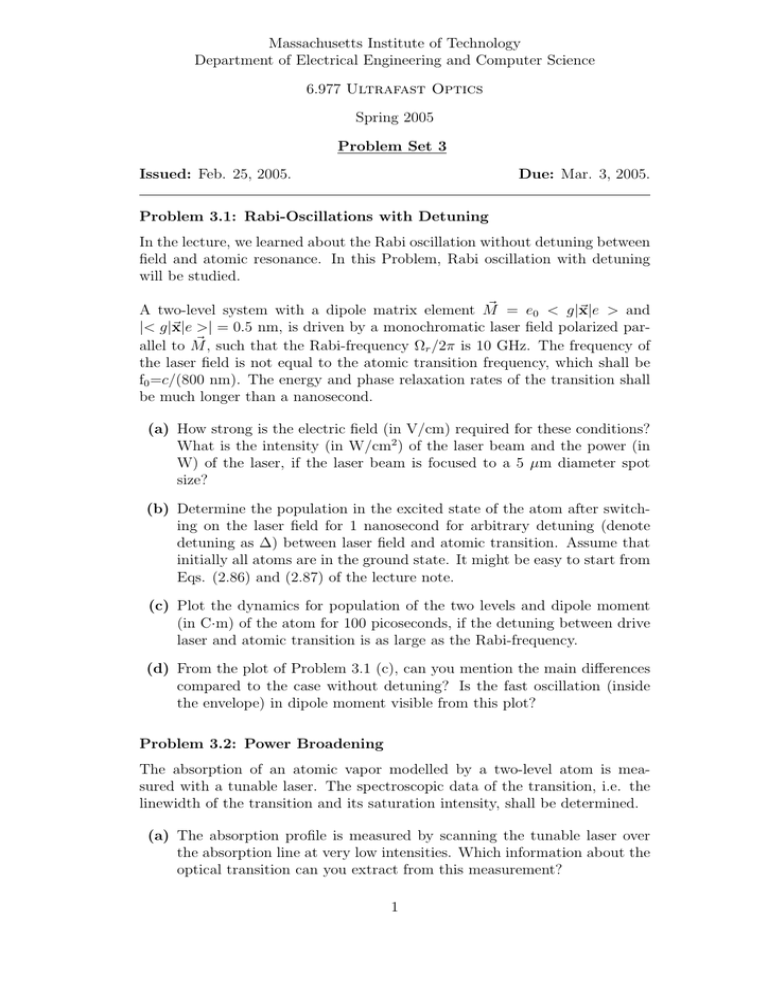Massachusetts Institute of Technology Department of Electrical Engineering and Computer Science
advertisement

Massachusetts Institute of Technology Department of Electrical Engineering and Computer Science 6.977 Ultrafast Optics Spring 2005 Problem Set 3 Issued: Feb. 25, 2005. Due: Mar. 3, 2005. Problem 3.1: Rabi-Oscillations with Detuning In the lecture, we learned about the Rabi oscillation without detuning between field and atomic resonance. In this Problem, Rabi oscillation with detuning will be studied. � = e0 < g |�x|e > and A two-level system with a dipole matrix element M |< g |�x|e >| = 0.5 nm, is driven by a monochromatic laser field polarized par­ � , such that the Rabi-frequency Ωr /2π is 10 GHz. The frequency of allel to M the laser field is not equal to the atomic transition frequency, which shall be f0 =c/(800 nm). The energy and phase relaxation rates of the transition shall be much longer than a nanosecond. (a) How strong is the electric field (in V/cm) required for these conditions? What is the intensity (in W/cm2 ) of the laser beam and the power (in W) of the laser, if the laser beam is focused to a 5 µm diameter spot size? (b) Determine the population in the excited state of the atom after switch­ ing on the laser field for 1 nanosecond for arbitrary detuning (denote detuning as Δ) between laser field and atomic transition. Assume that initially all atoms are in the ground state. It might be easy to start from Eqs. (2.86) and (2.87) of the lecture note. (c) Plot the dynamics for population of the two levels and dipole moment (in C·m) of the atom for 100 picoseconds, if the detuning between drive laser and atomic transition is as large as the Rabi-frequency. (d) From the plot of Problem 3.1 (c), can you mention the main differences compared to the case without detuning? Is the fast oscillation (inside the envelope) in dipole moment visible from this plot? Problem 3.2: Power Broadening The absorption of an atomic vapor modelled by a two-level atom is mea­ sured with a tunable laser. The spectroscopic data of the transition, i.e. the linewidth of the transition and its saturation intensity, shall be determined. (a) The absorption profile is measured by scanning the tunable laser over the absorption line at very low intensities. Which information about the optical transition can you extract from this measurement? 1 (b) The measurement in (a) is repeated at various power levels of the tun­ able laser. How does the shape of the measured absorption line change with the power level? Which information can you extract from this measurement? (c) Now a second powerful laser is focused into the vapor with an intensity I = 10 · Is . The measurement in (a) is repeated with the tunable laser at low intensity. What lineshape do you find? (Assume that (i) the spot size of the tunable laser beam is much smaller than the one of the powerful laser beam, (ii) they are centered at the same point, and (iii) there is no problem in separating both beams after propagation through the vapor.) Problem 3.3: Pulse Compression A pulse propagating through an optical fiber becomes frequency modulated due to self-phase modulation (SPM). The pulse is chirped and can be repre­ sented by 2 2 2 A(t) = e−Γ1 t · e−iΓ2 t · eiω0 t = e−Γt · eiω0 t (1) with Γ = Γ1 + iΓ2 , where Γ1 determines the initial pulse width and Γ2 the acquired chirp due to SPM (in this Problem, assume Γ2 is positive). The pulse can be compressed by the addition of dispersion generated by a grating pair or prism pair (as discussed in Problem Set 2) 2 A� (ω) = A(ω) · eiD2 (ω−ω0 ) . (2) (a) What is the new value for Γ� of the new pulse in terms of Γ1 , Γ2 and D2 ? In the following we assume that the input pulse is a Gaussian pulse (i.e. Γ1 = 1/2τ 2 ) and we take the action of self-phase modulation into account by expanding the nonlienar phase shift up to second order in time, so that equation (1) can be applied. (b) What is the peak nonlinear phase shift, φ0 = −Γ2 τ 2 , necessary to short­ ening of the pulse by a factor of two (in terms of FWHM of the intensity)? (c) What is the necessary dispersion to compress the pulse? Express the final answer in terms of τ . Can you find the reason why making negative dispersion with an artificial structure, such as prism-pair, grating-pair, or chirped mirror (which will be shown later in the class), is important in pulse compression? Problem 4.0: In the next Problem Set, you will be asked to write a simple program to simulate (1) the pulse compression and (2) the nonlinear Schrödinger equation for solitons. The “official language” for the simulation problems in this course will be MATLAB. Please indicate if you are familiar with MATLAB for this kind of problems. If you prefer to use another language, please mention which one you will use. 2



